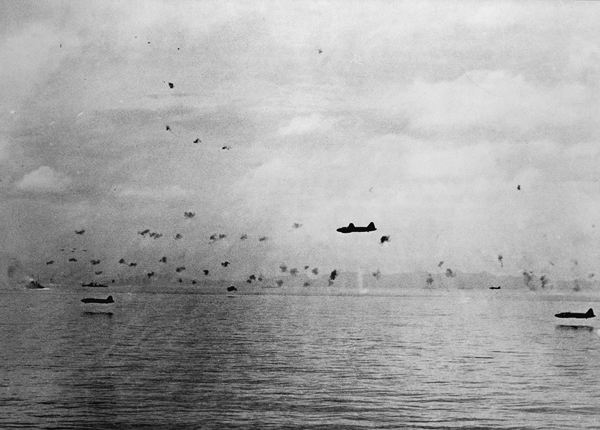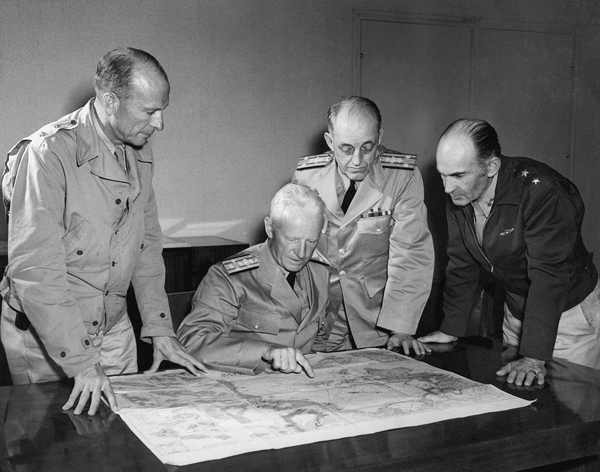The Conquering Tide (106 page)
Read The Conquering Tide Online
Authors: Ian W. Toll

The Conquering Tide
is the second in a projected three-volume history of the Pacific War. It resumes the narrative of
Pacific Crucible
(2011), which told the story of the first six months of the conflict, from Japan's surprise strike on Pearl Harbor to the Americans' devastating counterpunch at the Battle of Midway. The current volume covers the heart of the war, the period between mid-1942 and mid-1944, when parallel Allied counter-offensives north and south of the equator washed over Japan's far-flung island empire like a “conquering tide,” concluding with Japan's irreversible strategic defeat in the Marianas. As in the previous book, my purpose has been to assimilate into one narrative many distinct and sharply contrasting points of viewâthe Allied and Japanese sides of the conflict, the home fronts and the battle fronts, the highest levels of political and military leadership and the perspectives from the decks, trenches, and cockpits. I have set out to tell the entire story of the Pacific War, admittedly a daunting proposition even in three books whose cumulative length will surpass 1,500 pages. I believe I can claim that this trilogy will be the first history of the entire Pacific War to be published in at least twenty-five years, and the first multivolume chronicle of the naval war since Samuel Eliot Morison's fifteen-volume series, published in the late 1940s and 1950s. In the years since, the field has been deeply enriched. New archives have opened, new oral histories have been recorded, new memoirs have been published, new and old Japanese sources have been translated, and talented writers and scholars on both sides of the Pacific have shed light on various aspects of the conflict. But a “stay in your lane” mentality prevails among drivers on these freeways. As the literature has grown richer and more varied, it has become disjointed and piecemeal. We have had a conspicuous lack of well-integrated narratives about the Pacific War in its entirety.
The obvious challenge of any big historical narrative is to do justice to the breadth, depth, and complexity of its subject. The most sensible approach (also the simplest to research and easiest to write) would be a soaring, textbook-style overview that takes each major event in chronological turn. But that sort of effort could add little to what already exists, and would fail to deliver the immediacy, intimacy, and tension that are the lifeblood of a story. The alternative is an episodic narrative, a progression of “deep dives” into selected events or themes, each chosen to illuminate another dimension of the larger subject. The episodic approach relies overwhelmingly on the direct personal account, the eyewitness description, the telling detail, and the coincident emotions and shrewd insights of observers and participants. It avails itself of storytelling techniques found in novels and (dare I say it?) even films. It requires a calculated decision to pay a lot of attention to some things and little or none to others, and can therefore be hauled up on charges of omission or neglect. The episodic narrative, as readers of my previous books will attest, also has an incorrigible tendency to stray out of the conventional lanes of military history, perhaps even to weave all over the road. I plead guilty, and I expect to be back in court again tomorrow to answer the same charges with the same plea.
The firsthand accounts in this narrative are drawn in about equal proportions from archival and published sources. I have relied heavily on oral histories recorded and transcribed in past decades by the U.S. Naval Institute and Columbia University. In analyzing strategic and tactical decisions, I have gone back to the direct testimony of commanders in action reports, letters, war diaries, or contemporary debriefings. The detailed appendices at the end of major action reports sometimes provide a more penetrating analysis (how and why a battle was won or lost) than can be found in the historical literature. As in
Pacific Crucible
, I have frequently drawn from published collections of oral histories, diaries, or letters, not because these published primary accounts are more interesting than what can be dug up in archives, but because they happened to come first to hand. I have given special emphasis to obscure and out-of-print war memoirs, many published in the 1940s and 1950s, when the writers were in the prime of their lives and their memories were fresh. Memoirists are a self-selected breed; they tend to be naturally gifted writers with sharp opinions, fearless candor, and a cunning wit. They tell us not only how the war was waged but how it was lived. Their autobiographical
accounts deserve a special place in the historical record, but many have been neglected or disregarded.
Any history of this scope must be, at least in some sense, a synthesis of the best and most recent scholarship in the field. The source notes and bibliography identify what I believe to be the most important contributions. Where there is controversy, I have done my best to represent the contending points of view fairly before supplying my own conclusions.
I owe thanks to the staffs of the FDR Presidential Library, the National Archives, the Naval History and Heritage Command, and the Naval War College. Ronald Russell, former editor and webmaster of the Battle of Midway Roundtable (online at www.midway42.org), did me a generous service by reviewing this manuscript and providing detailed comments on both the history and the prose. On the same count, I offer fond thanks to my friend Floyd Beaver, a fine editor-writer and a direct eyewitness to several of the events depicted in this book. Jim Hornfischer read the manuscript and provided valuable feedback; his next book, on the Marianas, will be a must-read for all of us with an interest in the Pacific War. My friends Damian Smith, Lucy Walker, Andrew Maloney, Feyi Akindoyeni, and Kate Deverall hosted me during my research in Australia. Robyn Middleton generously turned up sources at the Australian War Memorial. Smith and Maloney went beyond the call of duty by accompanying me to Guadalcanal and Tulagi. In Japan, I especially want to express my deep appreciation for the support and assistance of Kiyohiko Arafune, Yukio Satoh, Susumu Shimoyama, Yukoh Watanabe, Naoyuki Agawa, and VADM Yoji Koda (JMSDF, ret.). For help with the photographs and bibliography, thanks to Christopher Keilman. Thanks again to my talented and dedicated mapmaker, Loren Doppenberg.
I am proud to report that Eric Simonoff, the hardest-working man in the book business, remains my agent.
I am indebted to the entire team at W. W. Norton. Ryan Harrington and Mary Babcock played significant roles in the production of this book. My editor, Starling Lawrence, has kindly accommodated my ignominious record of blown deadlines. He remains a valuable advocate, counselor, and friend.

Joint Chiefs of Staff (JCS) at a luncheon meeting, mid-1943. From left to right: General Henry H. “Hap” Arnold (USAAF), Admiral William D. Leahy, Admiral Ernest J. King, General George C. Marshall.
Official U.S. Navy Photograph
.

Rear Admiral Richmond Kelly Turner, USN (left), and Major General Alexander A. Vandegrift, USMC, on the flag bridge of the transport
McCawley
during the
WATCHTOWER
Operation.
Official U.S. Navy Photograph.

Japanese G4Ms armed with aerial torpedoes fly through antiaircraft bursts to attack the American fleet off Guadalcanal on August 8, 1942. Note the skilled wave-top approach.
Official U.S. Navy Photograph.

Henderson Field, Guadalcanal, in late August 1942. This aerial view looks northwest, with the Lunga River and Ironbottom Sound in the background. Bomb and shell craters pockmark the entire area.
Official U.S. Navy Photograph
.

Wreckage of a SBD scout bomber on Guadalcanal, still afire after being destroyed on the ground by a Japanese air attack.
Official U.S. Navy Photograph.

Battle of the Eastern Solomons, August 24, 1942. This photograph, taken from the island veranda of the
Enterprise
(CV-6), recorded the third of three bombs to strike the carrier in a huge Japanese dive-bombing attack.
Official U.S. Navy Photograph
.

